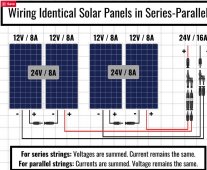Buying 8 100W 12v HQST panels: https://www.amazon.com/gp/product/B095WRXB55/ref=ox_sc_act_title_2?smid=A2D22KZJD14Y8Y&psc=1
and looking to choose the right controller for my 2 100Ah LiPo4 batteries that are joined in parallel to power through my 12v sine wave inverter.
I’m hoping I can wire the eight 100W 12v panels in series (8*12v=96v) (100W/12v=8.3Amps).
thinking that the 96v from the 8 panels in series (which barely falls below the controller’s “Max. PV Input Voltage: 100 VDC”) may work(?) However, I don’t expect more than 400W out of those 8-100W panels for much of the day and I need to run as much as 450 watts during the day so I may want to expand it later to include more panels..but this controller might not tolerate that higher voltage if I keep it all in series(?)
I have more trees than is ideal for solar. The HQST panels say they have a diode that helps the system get more power in partial shade situations.
1. Is this a wise configuration? Any alternative suggestions appreciated. I am a beginner.
2. Since I have as much as 30% wispy shade, should I just put this in parallel in the 1st place (and, if so, what is a good controller for that environment).
Thank you!
and looking to choose the right controller for my 2 100Ah LiPo4 batteries that are joined in parallel to power through my 12v sine wave inverter.
I’m hoping I can wire the eight 100W 12v panels in series (8*12v=96v) (100W/12v=8.3Amps).
I’m considering a Renogy Rover 20A 12V/24V Auto DC Input MPPT Solar Charge Controller $89.99
https://www.amazon.com/Renogy-Charg...e+controller+lithium+mmpt,aps,151&sr=8-3&th=1thinking that the 96v from the 8 panels in series (which barely falls below the controller’s “Max. PV Input Voltage: 100 VDC”) may work(?) However, I don’t expect more than 400W out of those 8-100W panels for much of the day and I need to run as much as 450 watts during the day so I may want to expand it later to include more panels..but this controller might not tolerate that higher voltage if I keep it all in series(?)
I have more trees than is ideal for solar. The HQST panels say they have a diode that helps the system get more power in partial shade situations.
1. Is this a wise configuration? Any alternative suggestions appreciated. I am a beginner.
2. Since I have as much as 30% wispy shade, should I just put this in parallel in the 1st place (and, if so, what is a good controller for that environment).
Thank you!







